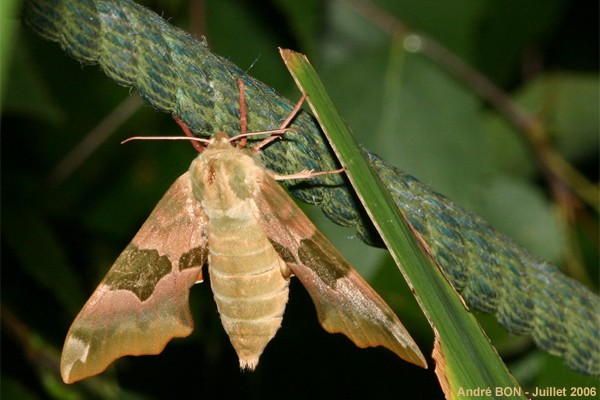
| Lime Hawk-moth (Mimas tiliae (Linnaeus, 1758)) |

|
|
Scientific name: Mimas tiliae (Linnaeus, 1758) Common name: Lime Hawk-moth French name: Sphinx du tilleul Order: Lepidoptera Suborder: Heterocera Family: Sphingidae Subfamily: Smerinthinae Wingspan: 70-80mm. Biotope: Locations where there are many host plants, so this includes towns where you can find rows of lime trees. Geographic area: Europe, Russia east to western Siberia. Near East. Flight time: May to July. Number of generations : Usually 1, 2 in the warmest areas. Caterpillar: It can reach 60 mm long. It is green with seven yellow and red stripes on the sides and a blue or purple horn at the rear. It becomes pinkish before it pupates. Host plant: Mainly Lime (Tilia), but also some other trees and shrubs: Oak (Quercus), Elm (Ulmus), Birch (Betula), Alder (Alnus), Mulberry (Morus) and Prunus. |
The ground colour of the Lime Hawk-moth's forewings is brown green but can also vary to ochreous or pinkish. The forewings show two dark brown or dark green blotches. They can merge to make a large cross mark. The hindwings are a uniform greyish brown colour. Males are usually smaller than females but more strongly marked. Imagos have a very short life as they do not feed. Lime Hawk-moths fly at night and are attracted to light. They overwinter as pupae in the soil. |
| [To know more about the Lime Hawk-moth] [Top] |

|
We were eating on the terrace when I saw an insect climbing up a lis in the basin. It finally hooked to the rope I used to attach a tree since the tempest of 1999. We discovered this beautiful Hawk-moth with the flash light. |